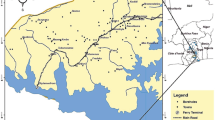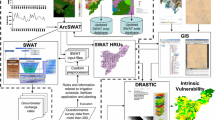Abstract
The use of indices, describing aquifer vulnerability and the risk of groundwater pollution, is a basic tool for the implementation of a sound water management plan, especially in densely populated and intensely cultivated areas. In this study, the groundwater contamination risk of the Caserta Plain (Southern Italy) was assessed through the integration of hazards defined on the basis of the different land uses, of the intrinsic vulnerability calculated by applying the SINTACS model and of the groundwater value evaluated by considering water wells density. In order to evaluate the evolution of the risk of groundwater pollution, the proposed methods were applied in the study area for both 2001 and 2009. The resulting specific vulnerability (SINTACS-L) and the risk (GRA) maps, created in a GIS environment, were validated by the comparison with the nitrate concentration distribution. The application of the proposed approach to the study area highlighted the strengths and weaknesses of each method and, at the same time, showed that their combination can provide an overall view of the threats posed to groundwater resources by the human activities affecting the territory. Considering both the benefits and the issues of the proposed approach, overall, the groundwater risk map is thought to be a robust tool to support water managers in defining future plans for water resources exploitation and land use.










Similar content being viewed by others
References
Ahmed I, Nazzal Y, Zaidi FK, Al-Arifi NSN, Ghrefat H, Naeem M (2015) Hydrogeological vulnerability and pollution risk mapping of the Saq and overlying aquifers using the SINTACS model and GIS techniques, NW Saudi Arabia. Environ Earth Sci 74(2):1303–1318. doi:10.1007/s12665-015-4120-5
Al-Adamat RAN, Foster IDL, Baban SMJ (2003) Groundwater vulnerability and risk mapping for the basaltic aquifer of the Azraq basin of Jordan using GIS, remote sensing and DRASTIC. Appl Geogr 23:303–324. doi:10.1016/j.apgeog.2003.08.007
Allen RG, Pereira LS, Raes D, Smith M (1998) Crop evapotranspiration—guidelines for computing crop water requirements. FAO Irrigation and drainage paper 56. Rome (IT)
Aller L, Bennett T, Lehr JH, Petty RJ, Hackett G (1987) DRASTIC: a standardized system for evaluating ground water pollution potential using hydrogeologic settings. EPA-600/2–87-035.7
Allocca V, Celico F, Celico P, De Vita P, Fabbrocino S, Mattia C, Monacelli G, Musilli I, Piscopo V, Scalise AR, Summa G, Tranfaglia G (2007) Carta Idrogeologica dell’Italia Meridionale. Istituto Poligrafico e Zecca dello Stato
Andreo B, Goldscheider N, Vadillo I, Vias JM, Neukum C, Sinreich M, Jiméneza P, Brechenmacher J, Carrasco F, Hötzl H, Perles MJ, Zwahlen F (2006) Karst groundwater protection: first application of a Pan-European approach to vulnerability, hazard and risk mapping in the Sierra de Libar (southern Spain). Sci Total Environ 357:54–73. doi:10.1016/j.scitotenv.2005.05.019
Aschonitis VG, Salemi E, Colombani N, Castaldelli G, Mastrocicco M (2013) Formulation of indices to describe intrinsic nitrogen transformation rates for the implementation of best management practices in agricultural lands. Water Air Soil Pollut 224(3):1489. doi:10.1007/s11270-013-1489-1
Babiker IS, Mohamed MAA, Hiyama T, Kato K (2005) A GIS-based DRASTIC model for assessing aquifer vulnerability in Kakamigahara Heights, Gifu Prefecture, central Japan. Sci Total Environ 345:127–140. doi:10.1016/j.scitotenv.2004.11.005
Billen G, Garnier J, Lassaletta L (2013) The nitrogen cascade from agricultural soils to the sea: modelling nitrogen transfers at regional watershed and global scales. Phil Trans R Soc B 368(1621):20130123. doi:10.1098/rstb.2013.0123
Bonardi G, D’Argenio D, Perrone V (1998) Carta Geologica dell’Appennino Meridionale. Memorie della Societa Geologica Italiana 41
Bruno PPG, Godio A (1997) Environmental risk assessment of a shallow aquifer in “Piana Campana” (Italy): a field comparison between sesimic refraction and reflection methods. Eur J Environ Eng Geophysics 2:61–76
Castaldelli G, Colombani N, Vincenzi F, Mastrocicco M (2013) Linking dissolved organic carbon, acetate and denitrification in agricultural soils. Environ Earth Sci 68(4):939–945. doi:10.1007/s12665-012-1796-7
Civita M, De Maio M (1997) SINTACS: Un sistema parametrico per la valutazione e la cartografia delle vulnerabilità degli acquiferi all’inquinamento. Metodologia e automatizzazione. PITAGORA EDITRICE, BOLOGNA, p. 191. ISBN 9788837108991
Civita M, De Maio M (2004) Assessing and mapping groundwater vulnerability to contamination: the Italian “combined” approach. Geofis Int 43(4):513–532
Corine Land Cover (2000) Version 12/2009. Raster data on land cover for the CLC2000 inventory
Corniello A, Ducci D, Ruggieri G (2007) Areal identification of groundwater nitrate contamination sources in periurban areas. J Soils Sediments 7(4):159–166. doi:10.1065/jss2007.03.213
Cuoco E, Colombani N, Darrah TH, Mastrocicco M, Tedesco D (2017) Geolithological and anthropogenic controls on the hydrochemistry of the Volturno River (Southern Italy). Hydrol Process 31(3):627–638. doi:10.1002/hyp.11055
Di Girolamo P (1968) Petrografia dei tufi campani: il processo di pipernizzazione (tufo-tufo pipernoide-piperno). Petrografia, rilevamento e natura ignimbritica del tufo campano del casertano. Rendiconto dell’Accademia delle Scienze Fisiche e Matematiche 35:329–394 (in Italian)
Ducci D (1999) GIS techniques for mapping groundwater contamination risk. Nat Hazards 20:279–294. doi:10.1023/A:1008192919933
Erickson M, Mayer A, Horn J (2002) Multi-objective optimal design of groundwater remediation systems: application of the niched Pareto genetic algorithm (NPGA). Adv Water Resour 25(1):51–65. doi:10.1016/S0309-1708(01)00020-3
Fadlelmawla AA, Fayad M, El-Gamily H, Rashid T, Mukhopadhyay A, Kotwicki V (2011) A land surface zoning approach based on three-component risk criteria for groundwater quality protection. Water Resour Manag 25:1677–1697. doi:10.1007/s11269-010-9767-9
Food and Agriculture Organization of the United Nations (2002) Fertilizer consumption by crops. FAO, Rome. p. 64
Foster SSD, Chilton PJ (2003) Groundwater: the processes and global significance of aquifer degradation. PHILOS T ROY SOC B 358(1440):1957–1972. doi:10.1098/rstb.2003.1380
Gennaro A (2002) I sistemi di terra della Campania. SELCA, Firenze. p 63
Gogu R, Dassargues A (2000) Current trends and future challenges in groundwater vulnerability assessment using overlay and index methods. Environ Geol 39(6):549–559. doi:10.1007/s002540050466
GWD 2006/118/EC. Directive of the European Parliament and of the council on the protection of groundwater against pollution and deterioration. 12/12/2006
Huan H, Jinsheng W, Yanguo T (2012) Assessment and validation of groundwater vulnerability to nitrate based on a modified DRASTIC model: a case study in Jilin City of Northeast China. Sci Total Environ 440:14–23. doi:10.1016/j.scitotenv.2012.08.037
Jia Y, Yu G, Gao Y, He N, Wang Q, Jiao C, Zuo Y (2016) Global inorganic nitrogen dry deposition inferred from ground- and space-based measurements. Sci Rep 6:19810. doi:10.1038/srep19810
Kazakis NA, Voudouris KS (2015) Groundwater vulnerability and pollution risk assessment of porous aquifers to nitrate: modifying the drastic method using quantitative parameters. J Hydrol 525:13–25. doi:10.1016/j.jhydrol.2015.03.035
Khan FI, Husain T, Hejazi R (2004) An overview and analysis of site remediation technologies. J Environ Manag 71(2):95–122. doi:10.1016/j.jenvman.2004.02.003
Knisel WG, Davis FM (2000) GLEAMS, Groundwater Loading Effects from Agricultural Management Systems V3.0. Publ. No. SEWRL-WGK/FMD-050199, U.S.D.A., Tifton, Georgia
Lockhart KM, King AM, Harter T (2013) Identifying sources of groundwater nitrate contamination in a large alluvial groundwater basin with highly diversified intensive agricultural production. J Cont Hydrol 151:140–154. doi:10.1016/j.jconhyd.2013.05.008
Mastrocicco M, Colombani N, Palpacelli S (2009) Fertilizers mobilization in alluvial aquifer: laboratory experiments. Environ Geol 56(7):1371–1381. doi:10.1007/s00254-008-1232-1
Mastrocicco M, Colombani N, Palpacelli S, Castaldelli G (2011a) Large tank experiment on nitrate fate and transport: the role of permeability distribution. Environ Earth Sci 63(5):903–914. doi:10.1007/s12665-010-0759-0
Mastrocicco M, Colombani N, Salemi E, Castaldelli G (2011b) Reactive modeling of denitrification in soils with natural and depleted organic matter. Water Air Soil Pollut 222(1–4):205–215. doi:10.1007/s11270-011-0817-6
Mimi ZA, Assi A (2009) Intrinsic vulnerability, hazard and risk mapping for karst aquifers: a case study. J Hydrol 364:298–310. doi:10.1016/j.jhydrol.2008.11.008
Morris BL, Foster SSD (2000) Cryptosporidium contamination hazard assessment and risk management for British groundwater sources. Water Sci Technol 41(7):67–77
Morris BL, Lawrence ARL, Chilton PJC, Adams B, Calow RC, Klinck BA (2003) Groundwater and its susceptibility to degradation: a global assessment of the problem and options for management. Early warning and assessment report series 03-3. United Nations Environment Programme, 126 pp
National Research Council (1997) Valuing ground water: economic concepts and approaches, 1th edn. The National Academies, Washington
Neshat A, Pradhan B (2015) An integrated DRASTIC model using probabilistic based frequency ratio and two new hybrid methods for groundwater vulnerability assessment. Nat Hazards 76(1):543–563. doi:10.1007/s11069-014-1503-y
Nguyet VTM, Goldscheider N (2006) A simplified methodology for mapping groundwater vulnerability and contamination risk, and its first application in a tropical karst area, Vietnam. Hydrogeol J 14:1666–1675. doi:10.1007/s10040-006-0069-5
Patacca E, Scandone P (2007) Geology of the southern Apennines. Bollettino della Società Geologica Italiana 7:75–119
Puckett LJ, Tesoriero AJ, Dubrovsky NM (2011) Nitrogen contamination of surficial aquifers—a growing legacy. Environ Sci Technol 45:839–844. doi:10.1021/es1038358
Saidi S, Bouri S, Ben Dhia H (2010) Groundwater vulnerability and risk mapping of the Hajeb-Jelma aquifer (central Tunisia) using a GIS-based DRASTIC model. Environ Earth Sci 59:1579–1588. doi:10.1007/s12665-009-0143-0
Saidi S, Bouri S, Ben Dhia H, Anselme B (2011) Assessment of groundwater risk using intrinsic vulnerability and hazard mapping: application to Souassi aquifer, Tunisian Sahel. Agric Water Manag 98:1671–1682. doi:10.1016/j.agwat.2011.06.005
Sbarbati C, Colombani N, Mastrocicco M, Aravena R, Petitta M (2015) Performance of different assessment methods to evaluate contaminant sources and fate in a coastal aquifer. Environ Sci Pollut Res 22(20):15536–15548. doi:10.1007/s11356-015-4731-0
Secunda S, Collin ML, Melloul AJ (1998) Groundwater vulnerability assessment using a composite model combining DRASTIC with extensive agricultural land use in Israel’s Sharon region. J Environ Manag 54:39–57. doi:10.1006/jema.1998.0221
Shrestha S, Semkuyu DJ, Pandey VP (2016) Assessment of groundwater vulnerability and risk to pollution in Kathmandu Valley, Nepal. Sci Total Environ 556:23–35. doi:10.1016/j.scitotenv.2016.03.021
Šimůnek J, van Genuchten MTh, Šejna M (2008) The HYDRUS-1D software package for simulating the one-dimensional movement of water, heat, and multiple solutes in variably-saturated media. Version 4.0. HYDRUS software Ser. 3. Department of Environmental Sciences, University of California, Riverside
Uricchio VF, Giordano R, Lopez N (2004) A fuzzy knowledge-based decision support system for groundwater pollution risk evaluation. J Environ Manag 73:189–197. doi:10.1016/j.jenvman.2004.06.011
Vrba J, Zaporozec A (1994) Guidebook on mapping groundwater vulnerability. International contributions to hydrogeology. Verlag Heinz Heise, Hannover, Germany. 131 pp
Wang J, He J, Chen H (2012) Assessment of groundwater contamination risk using hazard quantification, a modified SINTACS model and groundwater value, Beijing Plain, China. Sci Total Environ 432:216–226. doi:10.1016/j.scitotenv.2012.06.005
Zaporozec A (2002) Groundwater contamination inventory: a methodological guide. IHP-VI, Series on groundwater No. 2. Paris, France: UNESCO, 160 pp
Zwahlen F (2004) Vulnerability and risk mapping for the protection of carbonate (karst) aquifers, final report (COST action 620). European Commission, Directorate XII Science, Research and Development, Report EUR 20912, Brussels, 297 pp
Author information
Authors and Affiliations
Corresponding author
Additional information
This article is part of the Topical Collection on Water Resource Management for Sustainable Development.
Rights and permissions
About this article
Cite this article
Busico, G., Cuoco, E., Sirna, M. et al. Aquifer vulnerability and potential risk assessment: application to an intensely cultivated and densely populated area in Southern Italy. Arab J Geosci 10, 222 (2017). https://doi.org/10.1007/s12517-017-2996-y
Received:
Accepted:
Published:
DOI: https://doi.org/10.1007/s12517-017-2996-y




